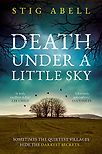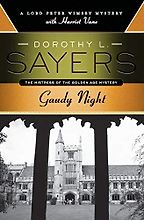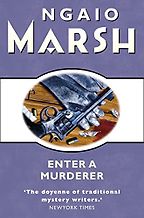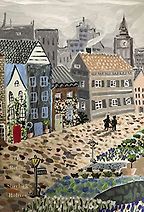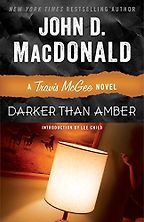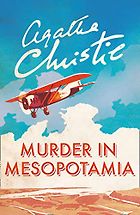Can you start by telling me what kind of crime books you’ve chosen? What were your criteria?
One of the great things about the genre of crime is that it is so unending, so generous and so wide-ranging. So if you said to me, ‘Pick five books with crime in’ I could have picked 500. And I could have picked very, very different ones, because it’s a funny old genre. It effectively begins at the end of the 19th century with Arthur Conan Doyle and Sherlock Holmes (I don’t really count Edgar Allan Poe, because he didn’t really lead anywhere directly). Then the golden age, with lots of them appearing, follows. So it’s only 120 or 130 years old. And yet it’s based geographically all over the world. It’s all sorts of different types of books—from very violent and bloody and hard-boiled to very gentle and feline and beautiful. It really is this massive tapestry of different types of books. So I think what I’ve ended up picking are probably classics, things that I think are central to the development of the genre.
You obviously really enjoy reading crime—as do I. Why is that do you think—do you find them comforting? What do you think it is that attracts you to the genre?
I was thinking about that. Some of it is definitely the comfort. In a very messy world of no real resolution, it is a very straightforward concept: here is a problem and here is a solution. There’s that line in Jane Austen where she talks about the telltale felicity of a book coming to an end, when you know things are about to get wrapped up. That always happens in crime novels. I like that.
I like the repetitive nature of crime. I love a series. I think a crime series really is one of the great pleasures in life, which is why I’m so thrilled to be writing one. When you find book 22 of a series, and you like it, you think, ‘oh my God, I’ve got 21 books to read!’ I won’t read books one to 21 all in one go—I’ll probably break it up with other books—so I’ve got a year’s worth of reading of something I know I really like. That familiarity, when you can find a character you love, or a scenario or a setting that you love, I think is also really important in crime fiction.
So where are you at with the series you’re writing? What was the concept behind it, how many books will be in it?
The first one, Death Under a Little Sky, is out now and I’ve got a deal to write three more. So there will be four of them. The second one is pretty much written and being proof edited and I’ve actually finished the first draft of the third one. I don’t know if the publisher is happy or just bemused by me, because all I want to do is sit and write these books. I’m not worried about deadlines, I’m not thinking, ‘How am I going to get it done?’ All I want to do is sit and write.
The series is about a detective, Jake Jackson, who leaves an unnamed city, and goes and lives in Little Sky, in this beautiful desolate countryside with no internet or phone lines, and then gets drawn back into the world of crime. The idea is that there can be an endless number of possible scenarios that will confront him in this new world of his, each one representing a novel. But the principle is really: person leaves a messy marriage and personal tragedy and the city and connected life and goes and lives somewhere more sedate, more desolate, and then starts to find a new life, meets a woman, finds a new experience and, at the same time, is involved in solving crime.
And where is Little Sky?
It doesn’t exist. I didn’t grow up there and I’m not harking back to it. It’s a fantasy location. There’s the word utopia, which is a pun in Greek, it’s both a great place and no place. That’s what Little Sky is, effectively. I say at some point it’s in the middle of England, but I don’t really say anything more than that. I’m actually from the Midlands, so maybe there’s a connection there. Some people have read it and said it reminds them of the West Country, some of East Anglia. I’ve had someone tell me it reminds them of parts of Scotland. It’s just a rural location which is desolate and free from the internet.
And were you inspired partly by a personal experience of going back to a simple life and having to relearn things?
I’m deeply impractical. So some of it is a fantasy of being able to cope by myself. Though it doesn’t feature in the book, the original idea came during Covid. There were all those conversations about relocation, resignation, appreciating the more basic things in life, the idea of the countryside over the city because of the unhealthiness of proximity. All of those ideas were, I think, in the ether when I was writing, and in my own mind.
I’m also a bit of a curmudgeon, so I like the idea of being away from it all. And, of course, in Covid, you couldn’t get away from anyone. We were living in a house with three small children and unable to leave. So the idea of expanse and horizons was also part of the fantasy, I think.
You captured that really well. It made me want to go and learn to fish.
I hope people will get that from the book. It’s not quite fantasy, because the book is quite gritty in some parts, but there is a certain sort of idealism permeating through it.
Let’s talk about the crime books you’ve recommended. The first one is Gaudy Night by Dorothy Sayers, one of the classic writers of the golden age of mystery. This was published in 1935 and for those who don’t know, a ‘gaudy’ is a reunion dinner that is still held at some of the UK’s more ancient universities. Tell me about this book and why you like it.
This is a really good example of how your relationship with a book changes over time. When I first read Gaudy Night, I thought, ‘Why am I reading this? There’s no murder in it. It’s people fannying about in Oxford. There’s a poison pen aspect to it and not much happens.’ Then I read it again. I love rereading crime books—it’s part of that comfort thing we were talking about—and I just fell in love with it. I’ve probably read Gaudy Night five or six times since then.
What I love about it is that it’s beautifully written. And I really love the two central characters. There’s a love story. If you look back, in the 1920s people used to write rules for detective fiction. It was a very formulaic, very structured genre back then. And one of the rules written by one man was, ‘Never have a love interest in a detective story. It ruins it.’ I think that’s complete rubbish—as you can tell from my book, which has a love interest at its heart.
“In a very messy world of no real resolution…here is a problem and here is a solution”
Gaudy Night is a beautiful love story. I love the relationship between Peter Wimsey and Harriet Vane. I just think it’s magnificent. I love the fact that he’s this damaged man who some people dismiss as a posh twit. He suffered during the First World War, he has post-traumatic stress syndrome, and is in love with this woman who he once saved from being hanged for murder in an earlier book.
It’s part of a series and that’s important. The setting in Oxford is brilliantly done. It’s charming. It’s very restful in parts. Nothing that bad happens for large chunks of it, so it’s quite soothing in that regard. All these things together epitomize what I love in the crime genre.
Have you read a lot of books by Dorothy Sayers?
Yes, I think I’ve read most of her books and I’ve certainly read all the Peter Wimsey books. The series was continued by another author, Jill Paton Walsh, and I’ve read all of those as well. Often when a series is continued after the author dies the books are rubbish, but these ones by Jill Paton Walsh are brilliant. So if you like the Wimsey/Vane books, the series goes on for another four books after Dorothy Sayers dies, and they’re also really good.
So is Gaudy Night her best book and a good one to start with?
Some people will say not enough happens in it, but I think that’s part of its charm. I do think it is her best. The other one I think is brilliant is Murder Must Advertise. It’s also part of the Peter Wimsey series. There’s no love interest in it. He goes undercover in a London ad agency, which is where Dorothy Sayers worked for a time herself. So what it’s like to be in a London ad agency in the 1920s is just brilliantly revealed. That’s a really good one as well.
In Gaudy Night, I found it interesting to read about being a woman at the University of Oxford in the early 20th century. Women were all in separate colleges and couldn’t formally get degrees.
Yes, and that must have been what it was like for Dorothy Sayers. She was a great intellectual and you can sense her personal experience in the book. That’s what makes Harriet Vane so brilliant. In the book, she’s a novelist. She doesn’t take any nonsense. She’s very conscious of the world she’s moving in and the limitations of it—what happens if you constantly dismiss women, if you put them in one part of the university and ask them to live by themselves. She’s very honest about the downside of that as well. The female college is very brilliantly done, and not everyone in it is a heroine.
Let’s go on to the next crime book you’re recommending. This is Enter a Murderer, which is also from 1935. It’s by Ngaio Marsh, who was a golden-age mystery writer from New Zealand. Tell me about her and about this book.
I came to Ngaio Marsh very late. I didn’t fully realize that during the golden age in Britain and its dominions—which included New Zealand at that time—the great authors were all women. Whereas in America they were all men: Raymond Chandler, Dashiell Hammett. Raymond Chandler hated British crime writing. He wrote this very funny article about how the books always had titles like Inspector Pinchbottle to the Rescue or Death Wears Yellow Garters. He said, “The English may not always be the best writers in the world, but they are incomparably the best dull writers.” He was setting himself up as the hard-boiled answer to the female writers in Britain he didn’t like, which included Agatha Christie, Dorothy Sayers, Margery Allingham (who is also brilliant) and Ngaio Marsh.
I’d never read Ngaio Marsh at all until about a year ago. Her inspector is brilliant. He’s called Roderick Alleyn. He’s very wry. He’s highly educated and is constantly quoting Shakespeare. He’s got a lovely relationship with his colleagues in Scotland Yard. Ngaio Marsh had a lot of experience in the theatre, so quite a lot of her novels are set there, including this one. She’s very good on what actors were like in the 1920s and 30s. They were horrors, many of them. The idea of the awful luvvie is brilliant in these books.
Five Books interviews are expensive to produce. If you're enjoying this interview, please support us by donating a small amount.
She is a very good example of a golden age, classical problem-solving detective writer, like Agatha Christie. The murder took place in a theatre: here’s a plan of the theatre, here is where all the people were. How can that person have got to there in time to do the murder? But her book is enlivened by the theatre stuff, which is very well-experienced and very funny. It’s beautifully written. Also, I think what you need in all of these books is at least one character who rises off the page. She came up with a detective who was very dry and funny and whimsical. The whimsy that you get in this novel is there in all of them. Have you read any Ngaio Marsh?
I’ve probably read three or four of the Roderick Alleyn series, but it was a while ago. I can’t quite remember which ones they were.
I think she gets lost in the mix because when you think of golden age writers you think of Agatha Christie first and Dorothy Sayers second. Not everyone would say Marjorie Allingham and even fewer Ngaio Marsh.
I’m not sure why I didn’t read more. Maybe her writing is a little too dense for me?
I think it might be the problem-solving. I’ve read several of hers and they’re not all brilliant, because sometimes the crimes are too complicated. I don’t like over-complicated crime novels because they can get very dense, where the problem is everything. In mine, I wrote everything over the shoulder of the main character, my detective. Everything that he sees and experiences you see and experience as the reader. Whereas a lot of these writers, including Marsh, dance around and you see several different perspectives and you look over the shoulder of different people. Then it’s quite hard, sometimes, to piece together precisely where everyone was. They’re not very modern, in that sense. The modern lack of an attention span suffers in some of her novels.
But Enter A Murderer is a good one.
I really liked it. Roderick Alleyn is very good in it. There is a journalist character in it. He’s a Watson-like figure who shouldn’t really be there but writes down what Alleyn says and listens to him being witty.
It’s amazing how all of these books mention Sherlock Holmes. I find it absolutely amazing that Conan Doyle both invented this genre and represented its high watermark. Most people who love these books would still say that the best creation ever was the first one. We’ve all been scrabbling around for 130 years, but Sherlock Holmes is still the best.
On that note, we’d better turn to the Conan Doyle book you’ve recommended. You’ve chosen The Return of Sherlock Holmes. So Holmes died in a previous story, “The Final Problem,” and then makes a comeback in this volume, which was first published in 1905. Is this the high point of Sherlock Holmes stories?
I’ve probably read the stories of Sherlock Holmes 200 or 300 times in my life, starting from when I was 11. I still read them now. They’re brilliantly written. What I love about this story is that Conan Doyle had written a character who was so good that when he decided to kill him off, he couldn’t because there was too much of a clamor.
So in “The Final Problem” Conan Doyle throws Holmes over the Reichenbach Falls. Then, in this book, in a relatively unconvincing fashion, he has to explain why Holmes didn’t die. So in the first story, “The Adventure of the Empty House,” he has Watson semi-bereft, living in London and thinking, ‘I can’t believe Sherlock is dead’ only to find out he didn’t die. Holmes had survived the fall, climbed back up the cliff, and had then gone off around the world chasing down the gang that nearly killed him. Holmes then bumps into Watson and they solve another crime.
“The Adventure of the Empty House” is a really good puzzle. It’s a locked-room murder, quite a famous one, where a man is sitting, counting his winnings in cards. The door is locked, the window is very high up: how did he die?
“We’ve all been scrabbling around for 130 years, but Sherlock Holmes is still the best”
But my favourite bit, the reason why I’ve chosen this story, is because at its heart is the friendship between Watson and Holmes. I’m a gross sentimentalist and I think in the end all these books live and die by the warmth of the characters. Sherlock Holmes spends all his time talking about himself as this cerebral creature, this brain. Does he actually have human, heartfelt relations?
In the story, Watson bumps into a hunchback selling books. They go into a room, Watson turns around, and then Holmes stands up and reveals himself. And Watson passes out with the joy of it all. Holmes then leans over him and says, ‘Oh, my God, I’m so pleased you’re okay.’ And you realize that even though Holmes is a very curmudgeonly, annoying, acerbic, coke- and tobacco-raddled figure, there is a beating heart within him. In the end, that beating heart is the thing I love about detective fiction. It’s true in all these books I’ve recommended. That story in The Return of Sherlock Holmes has a beating heart very visible in it.
So this volume has a number of stories?
Yes, Conan Doyle then goes off and writes lots more Sherlock Holmes stories. The Return of Sherlock Holmes has 13 stories and it’s got some of the classics. Some of the absolute best Sherlock Holmes stories are in this collection.
I could have picked the first Sherlock Holmes collection as well. I could have picked The Hound of the Baskervilles, which is brilliant. I could’ve picked anything Sherlock Holmes. But if someone said to me, ‘You can only reread one Sherlock Holmes story’ that first story in The Return would be the one for me. It’s both a brilliant locked-room mystery and you have Holmes returning. It’s great.
Also, in my book, there’s a bit where Jake discovers a secret compartment in the library he has inherited. He sees a book whose title is “The Adventure of the Norwood Builder,” which is a Sherlock Holmes story from this volume. In it, a man pretends to be killed and hides in a little room and Sherlock Holmes discovers that room. My little tribute to that is, if you pull back the book in the library, a secret compartment is revealed which advances the plot a little bit.
Yes, that library full of crime books was a very appealing idea in Death Under a Little Sky. Did you have that growing up?
I was born in 1980 and there were a very finite number of books in my house. There was no Amazon. I read and reread what was there, which included lots of genre novels, but it wasn’t thousands and thousands. I remember Penguin reissued some classic detective books, one of which was a Sherlock Holmes, in these very cheap, green paperbacks. I remember reading them a lot. But I had a finite number of genre novels.
So no, the idea that you could have a thriller library in the middle of this beautiful country farmhouse is unadulterated fantasy.
Now we’re at the only series I hadn’t read or heard of before. The author is an American called John MacDonald and you’ve chosen Darker than Amber, which is from 1966. Tell me about him and this book.
I love him. He’s not read very much in this country, but he sold millions of copies in his day. He wrote Cape Fear under a different title, The Executioners, so some people may have half-heard of him because of that.
I would definitely advise getting into his books. The only warning is that they were written in the 1960s and 70s and, especially with a male author writing a male protagonist, the sexual politics is not great. With all these books written more than half a century ago, they have their moments. There’s antisemitism, there’s racism. I don’t know what you think, but I feel fairly comfortable with that, if you’re able to read these books critically. I wouldn’t get rid of it, I wouldn’t rewrite it, I wouldn’t whitewash it. I’d just accept that it’s there and have a critical engagement with it. And you have to do that with John D. MacDonald.
But beyond that, they’re brilliant novels. The conceit behind the central character is magnificent. He’s called Travis McGee and lives in a boat called the Busted Flush in Florida. He wants to have his retirement while he’s still young enough to enjoy it. He’s this charming knight errant. People who have things stolen from them, who can’t get legal recourse, come to him. He says, ‘I’ll get it back for you, but I’ll take half the value.’ That’s how he earns money, and that enables him to live this beach bum lifestyle.
Each book has a colour in the title and each one is an attempt to recover something. He’s an environmentalist, which has dated well. He’s constantly bemoaning the building up of the Everglades and environmental pollution in Florida. His best friend, who helps him in Darker than Amber, is called Meyer and lives on a boat called the John Maynard Keynes. He’s this big, hairy economist—this wonderful, completely original sidekick you don’t really get anywhere else.
One writer who loves these books is Lee Child—and you can see a little bit of Jack Reacher in Travis McGee. He’s much more gregarious than Jack Reacher. It’s the idea of a man who goes into the uncharted, small-town badlands of America, where there are some pretty rough people. He’s really rough as well. He’s six foot five and good at fighting. He kicks ass and gets stuff back. But he also thinks about things.
If you like 60s Americana, there’s loads of it in the book. I think for people who’ve read lots of crime books but have never heard of John MacDonald, it’s quite nice to find a whole unexplored avenue. If you can just have a critical engagement with some of the sex side they’re brilliant. Darker than Amber is a really good tale. A woman is dropped with a cement block into a river where they’re fishing. Then they go after the people who went after her.
Have you read most of John MacDonald’s books?
I’ve read all of them. I’ve got them all in a line on a shelf at my house. The first one in the series is The Deep Blue Good-by, I think it may have been part of that Penguin paperback crime library I had growing up, so I read that. There are about 20 of them, and they’re mostly brilliant. I’ve read them multiple times. Again, it has this charming, very memorable figure at its heart, which I think is really nice. And whoever comes up with a sidekick who is an economist?
I was listening to the audiobook yesterday, and he kept saying, ‘Well, I’m an economist and therefore…’ It was very funny.
It is very funny. People might read this and think ‘I can take Dorothy Sayers and Sherlock Holmes, but John D. MacDonald is going too far.’ As I said, he’s not brilliantly read in this country but if you look at the history of publication, his books sold more than 30 million copies. That’s what it says on my mass market paperback, which I bought in the US. He was very much a figure.
Okay, let’s go to the last book you’ve chosen which is Murder in Mesopotamia. This is an Agatha Christie, but not one of her best-known ones—though it does features one of her best-known detectives, Hercule Poirot. Tell me more.
Agatha Christie is just there in the culture. If you grew up in this country, you can’t avoid her. It’s always been there. It’s there on television, although I don’t really love watching adaptations of any of these books. At some point in my life, I bought a whole bunch of Poirots. There are more than 30 of them. I just started reading them.
A lot of people love the later Christie, I like the early ones. This one is from 1936. It’s set at an archaeological dig. There’s a plan of the dig and where everyone’s rooms are. I don’t want to ruin it for anybody, but it’s quite a neat solution. It’s a good problem-solving one. In fact, the third book in my series (I’ve just written the first draft) is set in an archaeological dig, in a very mild tribute to this book.
It’s a good setting. It’s a finite group of people who are suspects. I like the way it’s written. Her framing devices are really good—there’s not just a straightforward narrator.
I love Hercule Poirot more than Miss Marple. I think Poirot is a more interesting figure. And I do have a fondness for the dramatic resolution. The ‘I’ve gathered you all in the room together and this is when I point the finger at the person who did it.’ The neatness of it is really appealing.
I like the fact that it’s set in Baghdad. Agatha Christie met her second husband there, who was an archaeologist, so the setting is based partly on her own experiences.
Yes, she really did love archaeology. She even wrote a book about it. Again, this book comes with a bit of a warning. Some of the people—the natives, as she would call them—aren’t necessarily rendered brilliantly sympathetically. You have to be conscious of that.
I just started rereading it and couldn’t remember any of it. Part of what I love about crime books is that I’m brilliant at completely forgetting them. I can then reread one as if it’s a totally new book.
I find with Agatha Christie in particular they’re all blurred in my head. I’ve probably read Murder in Mesopotamia three times in the last five years. I’ll probably read it again in another couple of years’ time. I just about remember the conceit of how the murderer does it, but I’ll have forgotten that in a year’s time.
Interview by Sophie Roell, Editor
April 16, 2023. Updated: April 19, 2023
Five Books aims to keep its book recommendations and interviews up to date. If you are the interviewee and would like to update your choice of books (or even just what you say about them) please email us at [email protected]

